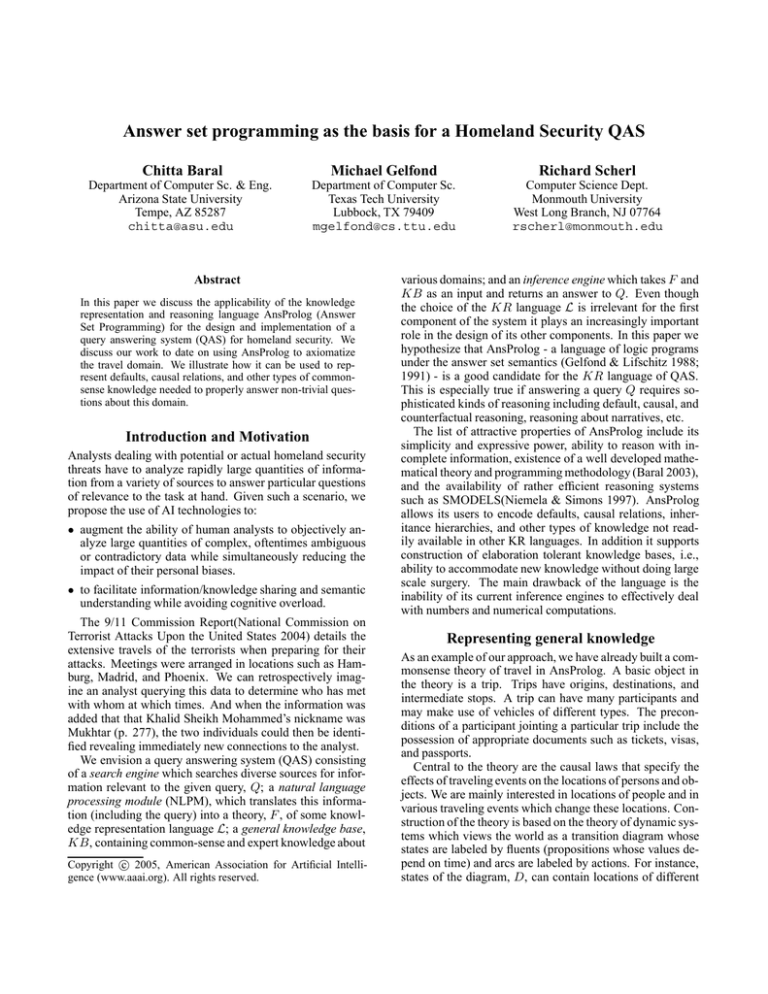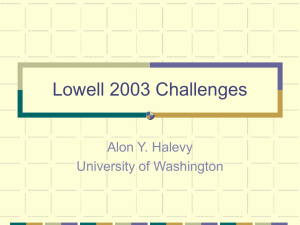
Answer set programming as the basis for a Homeland Security QAS
Chitta Baral
Michael Gelfond
Richard Scherl
Department of Computer Sc. & Eng.
Arizona State University
Tempe, AZ 85287
chitta@asu.edu
Department of Computer Sc.
Texas Tech University
Lubbock, TX 79409
mgelfond@cs.ttu.edu
Computer Science Dept.
Monmouth University
West Long Branch, NJ 07764
rscherl@monmouth.edu
Abstract
In this paper we discuss the applicability of the knowledge
representation and reasoning language AnsProlog (Answer
Set Programming) for the design and implementation of a
query answering system (QAS) for homeland security. We
discuss our work to date on using AnsProlog to axiomatize
the travel domain. We illustrate how it can be used to represent defaults, causal relations, and other types of commonsense knowledge needed to properly answer non-trivial questions about this domain.
Introduction and Motivation
Analysts dealing with potential or actual homeland security
threats have to analyze rapidly large quantities of information from a variety of sources to answer particular questions
of relevance to the task at hand. Given such a scenario, we
propose the use of AI technologies to:
• augment the ability of human analysts to objectively analyze large quantities of complex, oftentimes ambiguous
or contradictory data while simultaneously reducing the
impact of their personal biases.
• to facilitate information/knowledge sharing and semantic
understanding while avoiding cognitive overload.
The 9/11 Commission Report(National Commission on
Terrorist Attacks Upon the United States 2004) details the
extensive travels of the terrorists when preparing for their
attacks. Meetings were arranged in locations such as Hamburg, Madrid, and Phoenix. We can retrospectively imagine an analyst querying this data to determine who has met
with whom at which times. And when the information was
added that that Khalid Sheikh Mohammed’s nickname was
Mukhtar (p. 277), the two individuals could then be identified revealing immediately new connections to the analyst.
We envision a query answering system (QAS) consisting
of a search engine which searches diverse sources for information relevant to the given query, Q; a natural language
processing module (NLPM), which translates this information (including the query) into a theory, F , of some knowledge representation language L; a general knowledge base,
KB, containing common-sense and expert knowledge about
c 2005, American Association for Artificial IntelliCopyright gence (www.aaai.org). All rights reserved.
various domains; and an inference engine which takes F and
KB as an input and returns an answer to Q. Even though
the choice of the KR language L is irrelevant for the first
component of the system it plays an increasingly important
role in the design of its other components. In this paper we
hypothesize that AnsProlog - a language of logic programs
under the answer set semantics (Gelfond & Lifschitz 1988;
1991) - is a good candidate for the KR language of QAS.
This is especially true if answering a query Q requires sophisticated kinds of reasoning including default, causal, and
counterfactual reasoning, reasoning about narratives, etc.
The list of attractive properties of AnsProlog include its
simplicity and expressive power, ability to reason with incomplete information, existence of a well developed mathematical theory and programming methodology (Baral 2003),
and the availability of rather efficient reasoning systems
such as SMODELS(Niemela & Simons 1997). AnsProlog
allows its users to encode defaults, causal relations, inheritance hierarchies, and other types of knowledge not readily available in other KR languages. In addition it supports
construction of elaboration tolerant knowledge bases, i.e.,
ability to accommodate new knowledge without doing large
scale surgery. The main drawback of the language is the
inability of its current inference engines to effectively deal
with numbers and numerical computations.
Representing general knowledge
As an example of our approach, we have already built a commonsense theory of travel in AnsProlog. A basic object in
the theory is a trip. Trips have origins, destinations, and
intermediate stops. A trip can have many participants and
may make use of vehicles of different types. The preconditions of a participant jointing a particular trip include the
possession of appropriate documents such as tickets, visas,
and passports.
Central to the theory are the causal laws that specify the
effects of traveling events on the locations of persons and objects. We are mainly interested in locations of people and in
various traveling events which change these locations. Construction of the theory is based on the theory of dynamic systems which views the world as a transition diagram whose
states are labeled by fluents (propositions whose values depend on time) and arcs are labeled by actions. For instance,
states of the diagram, D, can contain locations of different
people; a transition σ 0 , {a1 , a2 }, σ1 ∈ D iff σ1 is a possible state of the domain after the concurrent execution of
actions a1 and a2 in σ0 . There is a well developed methodology of representing dynamic domain in AnsProlog (Baral
& Gelfond 2000; Turner 1997) which has been used in a
somewhat simplified form.n
This theory also interacts with other modules. One module contains geographical information about cities, countries, regions of the world and the relationship between
them. This module provides information about which cities
are in which countries and which countries are in which regions of the world. We assume that the theory is complete
so that negative information can be concluded via the closed
world assumption. Additionally, a theory of calendrical and
temporal information is also needed. This module contains
axioms about days, months, years, seasons and their relationships.
Using these theories we can translate various scenarios
into our AnsProlog notation and answer queries. Consider
the following scenario and query:
John took the plane from Paris to Baghdad. On the way
the plane stopped in Rome. Where is John?
The scenario is translated as follows:
h(at(john, paris),0).
o(go_on(john,f(paris,baghdad)),0).
mode_of_transp(f(paris,baghdad),air).
o(stop(f(paris,baghdad),rome),2).
Here a particular trip from paris to baghdad is named
f(paris,baghdad). The predicate h is used to indicate
the truth of a particular fluent at a particular time point and
o is used to indicate the occurrence of an action.
The query is:
h(at(john,baghdad),n).
Here n is used to represent a later point in time. The translation of the scenario and query into AnsProlog correctly
yields the answer “yes” when combined with our commonsense theory of travel, since trips (along with their participants) generally by default continue to their destination as
indicated by the following default.
o(stop(F,D),T) :- h(at(F,en_route),T),
dest(F,D),
not -o(stop(F,D),T).
The default rule essentially states that a trip will stop at a
particular destination at a particular point in time if there
is no reason to conclude (default negation – not) that the
action does not occur (logical negation -). Other axioms
specify that if a stop action occurs, all participants in the trip
are at the location at the next point in time.
On the other hand, consider a slightly different scenario
and query:
John took the plane from Paris to Baghdad. On the way,
the plane stopped in Rome, where John was arrested. Is
John in Baghdad?
Now we obtain the answer “No” since the default was overridden by the “arrest” action. An arrest axiom is axiomatized as removing the object of the arrest as a participant in
the trip.
The current system can also answer queries involving
dates and typical durations of trips. Additionally, we have
developed a planning module to determine if an actor can
(given a particular set of facts) be in a particular location by
a particular date. Furthermore, to a limited extent the theory
allows reasoning about plans or intentions of actors.
Current Work
Our current work is focused on a number of issues including:
• The development of reasoning systems that combine
AnsProlog modules with Prolog modules to overcome the
weakness of AnsProlog inference engines in dealing with
numbers and numerical calculations.
• Extending the work reported above to handle more
complex queries such as counterfactual reasoning and
plan/intention recognition.
• Automating the translation of English scenarios and questions into AnsProlog.
• Adding further theories to handle reasoning about
weapons of mass destruction and monetary transactions.
Summary
In conclusion, we feel that the features of AnsProlog are
well suited to form the foundations for an inference engine
supporting a QAS. Our future work will develop the support tools and implementation needed to demonstrate this
hypothesis.
Acknowledgments
This work has been supported by ARDA under award number 2004-H900700-000.
References
Baral, C., and Gelfond, M. 2000. Reasoning agents in dynamic domains. In Minker, J., ed., Logic Based AI. Kluwer.
Baral, C. 2003. Knowledge representation, reasoning and
declarative problem solving. Cambridge University Press.
Gelfond, M., and Lifschitz, V. 1988. The stable model
semantics for logic programming. In Kowalski, R., and
Bowen, K., eds., Logic Programming: Proc. of the Fifth
Int’l Conf. and Symp., 1070–1080. MIT Press.
Gelfond, M., and Lifschitz, V. 1991. Classical negation in
logic programs and disjunctive databases. New Generation
Computing 9:365–387.
National Commission on Terrorist Attacks Upon the
United States. 2004. The 9/11 Commission Report. W.W.
Norton & Company.
Niemela, I., and Simons, P. 1997. Smodels – an implementation of the stable model and well-founded semantics for
normal logic programs. In Proc. 4th international conference on Logic programming and non-monotonic reasoning,
420–429.
Turner, H. 1997. Representing actions in logic programs
and default theories. Journal of Logic Programming 31(13):245–298.





